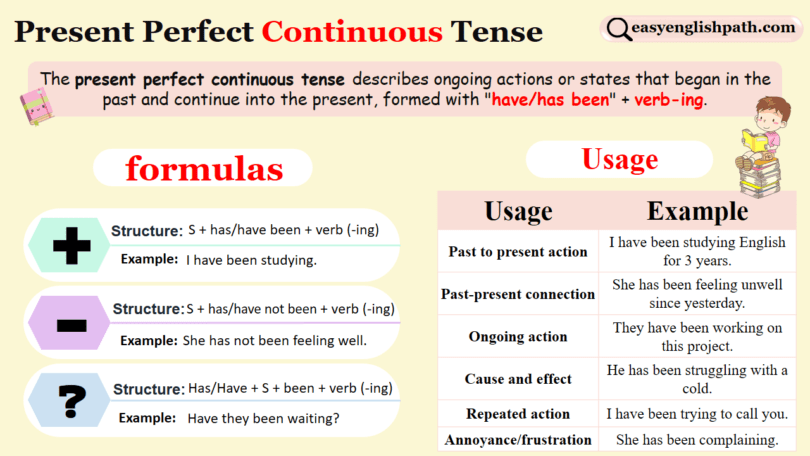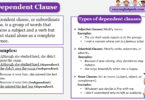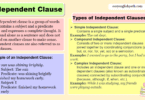The Present Perfect Continuous tense is used to talk about actions that started in the past and are still happening or have just finished. It helps us show that something started before now and has been continuing. We use it to talk about actions that have been going on for some time and are still relevant. It’s formed by using have or has with been and the -ing form of a verb. This tense helps us describe ongoing activities and their duration, making it easier to understand when something started and how long it has been happening.
Present Perfect Continuous Definition:
The Present Perfect Continuous tense is used to express actions that began in the past and are still ongoing or have just been completed. It is used to emphasize the duration or continuous nature of an action. This tense uses the present tense of the auxiliary verb to have (has/have), the past participle been, and the present participle (-ing) form of the main verb.
She has been cooking.
They have been laughing.
We have been waiting.
How to Form Negatives?
| Subject + have/has + not + been + present participle (-ing) |
To form a negative sentence in the Present Perfect Continuous tense, you want to say that something has not been happening over a specified duration leading up to the present moment.
You start with the subject (the person or thing doing the action), followed by the appropriate form of the auxiliary verb have (either have or has depending on the subject), then do not indicate the negative, then “been,” and finally the present participle (-ing form) of the main verb.
Examples:
She has not been cooking.
They have not been traveling.
We have not been talking.
She has not been cooking for two hours.
In contracted form, this becomes a more informal and commonly used way of expressing the same idea.
I haven’t been studying.
She hasn’t been cooking.
They haven’t been traveling.
She hasn’t been cooking for two hours.
How to Form Positives?
| [Subject] + [have/has] + [been] + [verb-ing] |
To form the positive Present Perfect Continuous tense, firstly you start with the person or thing doing the action, like I, you, he, she, it, we, or they. Then, you add have or has depending on who’s doing the action. If it’s I, you, we, or they, you use have. If it’s he, she, or it, you use has. Next, you include been, which shows that the action started in the past and is still happening now or just stopped. Finally, you use the main verb with “ing” at the end to show the ongoing action.
She has been dancing
They have been eating.
We have been talking.
They have been eating for thirty minutes.
How to Form Questions?
| Have/Has + Subject + Been + Main Verb-ing +? |
When we form questions in the Present Perfect Continuous tense involves rearranging the word order and adding the auxiliary verb have or has at the beginning of the sentence. Here’s the structure:
| Have + I + Been + Studying +? |
Has she been cooking?
Have they been traveling?
Have we been talking?
Have we been talking since this morning?
In each case, the word order changes to place the auxiliary verb at the beginning, and then the subject follows, followed by being, the main verb in its present participle form, and finally, the question mark.
Present Perfect Continuous Tense Vs Present Perfect Tense:
|
Present Perfect Continuous Tense |
Present Perfect Tense |
| The Present Perfect Continuous tense is formed using “has/have been” followed by the present participle (-ing form) of the verb. This tense indicates an ongoing action that started in the past and continues into the present or has just stopped. | The Present Perfect tense is formed using “has/have” followed by the past participle of the verb. This tense indicates an action completed at an unspecified time before now. |
| For Example: She has been studying for two hours. | For Example: She has studied for two hours. |
| The above sentence emphasizes the duration of the action, highlighting that she has been engaged in studying continuously for a specified period. | The above sentence emphasizes the result of the action, stating that she has completed two hours of studying without specifying whether it was continuous or not. |
You May Also like this






